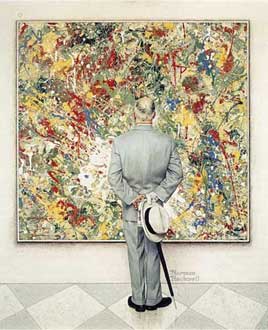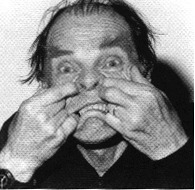Serendip is an independent site partnering with faculty at multiple colleges and universities around the world. Happy exploring!
Notes Towards Day 15, Part II--On an Erotics of Art
Second Set of Papers should be up...
For next Tuesday, read as far as you can get
in Leaves of Grass (1/2-way; c. 50 pp?)
To Make the Transition....
From Beyond History to
An Erotics of Art-->
Let's start w/ a couple of images....
What do you see? What do you feel? What are you experiencing?
What shape or figure?
What is background? What is foreground?
What is being abstracted?
Has form been "purified" in this painting?
Has historical content been "eliminated"?
Jackson Pollock, "The Deep" (1953)
Got the idea of starting w/ him from a book edited by
Edwin Haviland Miller, The Artistic Legacy of Walt Whitman,
which looks @ the repercussions of Whitman’s heritage in terms of
the psychic life and creative attitudes of contemporary artists
“The Radical Vision of Whitman and Pollock”:
visual counterparts of Whitman’s 'verbal transitoriness':
endless gyrations of Pollack’s all-over canvases
Pollock, "Greyed Rainbow" (1953)
Such an approach to representation can be frustrating for a spectator
(who might be?) seeking resolution, focus, a center of interest.
One way to think about this “absence of form”
is as a modernized realism
order of ceaseless change,
is indebted to Lucretius, Montaigne, primitivism,
sings of “disorderly,” contradictory life.
Whitman wrote, “Prais’d be the fathomless universe."
Pollock said, “The source of my painting is the unconscious.”
Pollock had many (other) ancestors
(thinking now of how you know an organism:
identified by its ancestors):
Native American sandpainting,
the Mexican muralists ,
Surrealist automatism,
He usually had an idea of how he
wanted a particular piece to appear.
His technique combined the movement of his body,
over which he had control,
and the absorption of paint into the canvas.
Pollock's advice: "look passively and try to receive
what the painting has to offer and
not bring a subject matter or preconceived idea
of what they are to be looking for."

Cover, Saturday Evening Post, January 13, 1962
Pollock's work (and advice about reading his work)
is a great example/test case for Susan Sontag's advice, in
"...reactionary, impertinent, cowardly, stifling…"
"Real art has the capacity to make us nervous…
interpreting…tames the work of art…
makes art manageable, comformable....
To interpret is to impoverish, to deplete the world....
What matters is the
pure,
untranslatable,
sensuous
immediacy.
Interpretation...indicates a dissatisfaction…with the work,
a wish to replace it by something else…
makes art into an article for use.
Abstract painting is the attempt
to have…no interpretation…
What is needed...is more attention to form in art ....
Valuable acts of criticism...reveal the sensuous surface of art.….
experiencing the luminousness of the thing in itself,
of things being what they are…
What is important now is to recover our senses.
We must learn to see
more, to hear more, to feel more…
Our task is to cut back content so
that we see the thing at all.
The aim of all commentary…should be to
make works of art—
and, by analogy, our own experience—
more, rather than less, real to us.
The function of criticism should be to show how it is what it is,
even
that it is what it is, rather than to show what it means.
In place of a hermeneutics we need an erotics of art.
positions of Feyerabend with Sontag??
What similarities, what differences,
did you notice in what they had to say???
In our current metaphor, are they
being or refusing to be piano keys?
Or refusing the metaphor altogether?
 |
Feyerabend, “Against Method” (1975):
Science is an essentially anarchistic enterprise.
A complex medium containing surprising and unforeseen developments demands complex procedures and defies analysis on the basis of rules which have been set up in advance....The world we want to explore is a largely unknown entity...The idea of a fixed method…rests on too naïve a view of man and his social surroundings…only one principle...can be defended under all circumstances…
What would Sontag say to that position?


